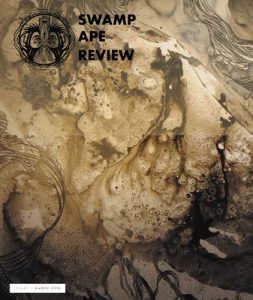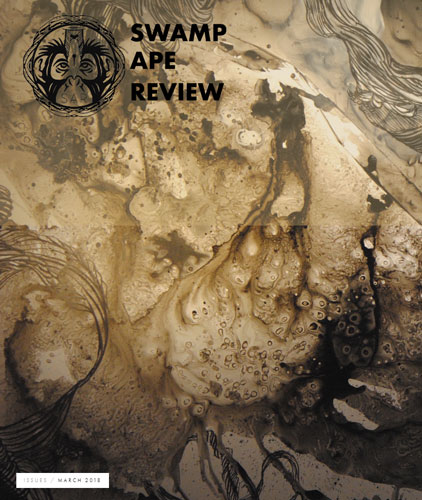
Founded last year at Florida Atlantic University, Swamp Ape Review has just dropped its second online issue. Issues are split into two sections, one featuring work by writers from South Florida, and the other featuring work from elsewhere. With the name Swamp Ape Review, one can’t help thinking of the weird and wild, and the editors don’t disappoint with their choices.
Scott Cunningham treats us to both the weird and wild with his set of poems “Three Poems about Plants That Eat People,” which opens the door to further reading. Among the three poems is “[Ya Te Veo],” which lead me to read more about the plant it was named after. I always appreciate when I walk away from a poem having learned something new.
In a piece reminiscent of Joshua Ferris’s Then We Came to the End, Frank Houston (one of the South Florida writers) introduces readers to the titular business his unnamed narrator(s) work at: “O’Reilly and O’Reilly and O’Reilly and Sons.” None of the O’Reillys are given a first name, making for a comical effect as they’re described and referred to: “O’Reilly constantly berated O’Reilly for this oddball behavior.” Houston describes the O’Reillys with rich detail: “He ruled the firm with a blend of smarmy machismo and abject paranoia. He had a bulbous, Romulan forehead, the back of his neck was constantly moist, and sweat beaded around the fine zigzagging veins at his temples.” With these descriptions, we’re brought into the office with the others, sitting through painfully awkward secret Santa gift exchanges, gossiping about the past of each O’Reilly, wondering about the person who threw themselves from the roof of the building. Houston gives us an entertaining story to sink into.
Brooke White discusses her relationship with her mother and her appearance in her nonfiction piece “In a Box with a Few Tiny Teeth.” Beginning, “Your aunts surprised your mother with a trip to the salon to have her hair cut. On the phone, she tells you her long hair made her feel ‘trapped.’ You want to laugh,” the piece then traces back through the complicated feelings surrounding hair—the complicated feelings of being trapped. White’s hair is a point of contention between her and her mother, her mom insisting that long hair is tied to beauty, power through beauty, femininity, and being wanted. The title comes from a paragraph halfway through the piece:
Then and now, in your mother’s house, is a box with a few tiny teeth and a lock of your hair inside. The box is iris, your mother’s favorite color. She painted this box and it sticks slightly when you slide the lid. Inside is a bundle of gold, wound together by a small hairband. This was your hair when it was soft, wheat colored, curled. Your mother keeps the hair locked away with your baby teeth, untouched by all but time.
Later, when her mother’s hair is accidentally cut too short by a hairdresser, she takes her locks home and cries over her loss. White connects each moment this way, gently ushering us along from one paragraph to the next, coming back to the idea of being trapped repeatedly. While White feels trapped by her mother, the insecurities she pins to her, and her physical and mental illnesses, her mother then feels trapped by the cage she built around appearance and hair: “‘I’m glad I got it cut. My long hair made me feel trapped,’ she says.” Partially a piece about familial relationships and partially about autonomy over appearance, White writes with skill and candor.
Continuing with familial themes is “Yemaya” by Geoffrey Philp. In this poem, the speaker gathers “plastic foam and bits / of wood to build a raft that nobody said would take / me past the sentinels and into the Florida straits.” Praying to Yemaya, the goddess of the ocean, the speaker asks for protection while simultaneously asking for forgiveness: “surely you will understand / that to save my family, I had to leave them behind.” The reader is left to consider the price of safety and what one is willing to sacrifice for it. Do you wait to be engulfed by flames in a burning building or do you climb to the roof and jump? Philp’s other two poems, “Distant Cousins” and “Homage to the Ancestors” stick with the family theme.
My favorite section of the issue is the Swamp, home to the more experimental. Henry Goldkamp’s “7 seconds at a woman on her porch” is an experience that utilizes audio, photography, and words, a piece I scrolled through again and again as I soaked it in. In the same section, Maureen Seaton and Neil de la Flor work down the alphabet with “An Autobiography of Letters,” the writers creatively playing with words and letters, separating them and running them into each other as they work down the page. Donovan Borger’s “A Short History of Explosions” mixes forms to work through ages seven through seventeen while exploring different explosions: IEDs, squashed beetles, betrayals of trust.
There is plenty of art to enjoy in this issue once readers have made their way through the Swamp. Among my favorites are Bernadette Despujols’s odd and imaginative pieces that combine everyday objects with organic, human materials (hair and a model tongue in this case); Tawni Shuler-LaDell’s earthy mixed media collages; and the foggy, dreamlike 35mm photographs by Tao Ho.
You don’t need to be from Florida to appreciate what Swamp Ape Review brings to the table. Readers with an appreciation for the unexpected and unique will find themselves welcomed by whatever may be lurking in the swamp.
[www.swampapereview.com]
Review by Katy Haas


